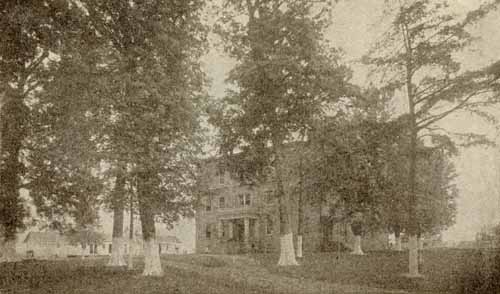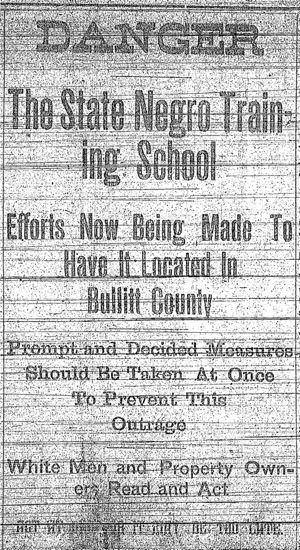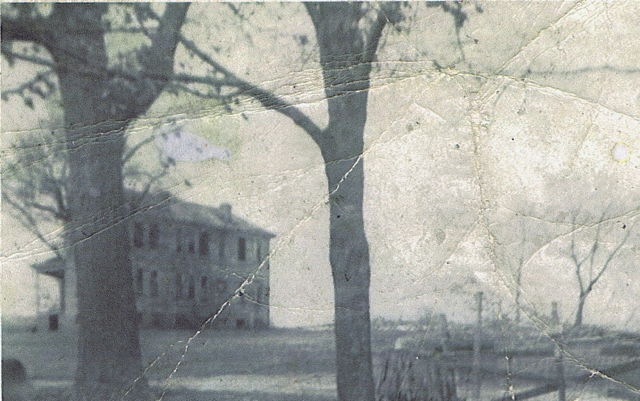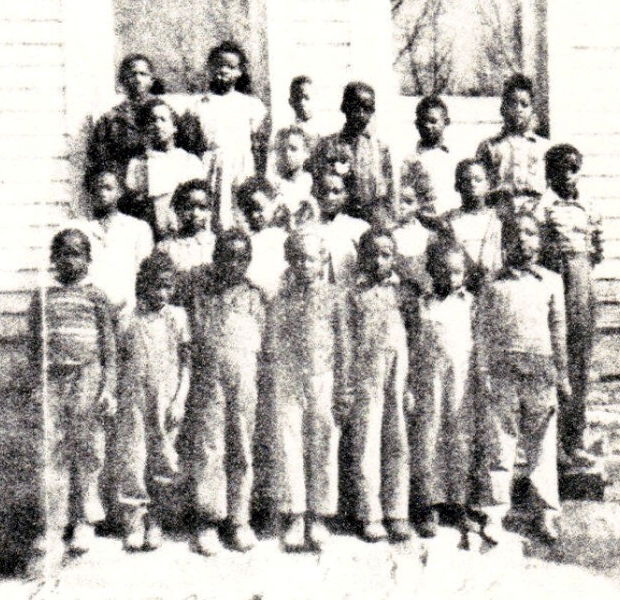
by
Daniel Buxton
Early History
African Americans have faced many challenges, adversities, and triumphs in trying to get a fair education. In Bullitt County, Kentucky the story is no different. In the state of Kentucky, African American Schools were attempted as early as 1827. For Bullitt County the earliest record of an African American School is that of the Noble School. According to the records, that school was burned to the ground on October 1, 1867. There were also two churches that were being used as schools and they were burned down as well. The Legislative Act of 1874, passed by the Kentucky Legislature, established the first system of public schools for African Americans in the state.
Eckstein Norton University

In 1899 property was purchased with the help of a $3000 donation from L&N Railroad officials. The University was located on 75 acres of land in Cane Springs, Bullitt County, Kentucky and was founded by Rev. William J. Simmons and C.H. Parrish. The School was named after Eckstein Norton, a banker and a railroad financier who donated a significant amount of money to the school. Eckstein Norton University was incorporated on August 19, 1899 and opened on October 5, 1890. On October 30, 1890 sorrow fell on the University when its President William James Simmons died in Louisville, Kentucky. Sometime later the school faced adversity again when its building burned down. A new brick building was built that had 25 rooms with big halls and porches. There were six frames buildings that were dormitories that had a total of 30 rooms. There was an assembly hall, printing office, a laundry, blacksmith shop and a music conservatory. When the University opened, the enrollment was 24 students with 16 teachers. In 1896 the university opened with students from 14 different states. In 1902 there were 83 students enrolled and 10 teachers. During the 1905 and 1906 school year there were 80 students enrolled and by 1908 117 enrolled. The University also had a brass band under the direction of Professor R.R. Brown and band leader John White, that played before Theodore Roosevelt at the laying of the cornerstone memorial building at Abraham Lincoln's birthplace near Hodgenville on February 12, 1909 and also played before president Diaz of Mexico and at the cornerstone-laying of Berea Hall at Lincoln Institute. The band toured the western United States soliciting funds and students for the university. By 1911 Eckstein Norton University had taught a total of 1794 Students. The College issued BA or BS degrees and issued a total of 189 degrees between 1892 and 1911. Through the hard work of the President C.H. Parrish and the Calvary Baptist Church they raised $400,000 to establish a new university. In 1911 Eckstein Norton would merge with Berea College and together they would establish Lincoln Institute which was located in Shelby County, Kentucky and opened on October 1, 1912. Eckstein Norton was shut down and the students transferred to Lincoln Institute and became alumni of that place.
First Records of African American Schools in Bullitt County
In 1893 Bullitt County School Superintendent W.C. Hays reported that for the school year ending June 30, 1892 there were seven African American Schools in Bullitt County. Of those seven, one was a log school house and the other six were frame. There were a total of 369 African American students according to the census but only a total of 215 enrolled in school. Four of these schools were in session for a four month term and three of them were in session for a five month term.
In 1897 Superintendent of Schools W. Jeff Lee reported on the 1895-1896 and 1896-1897 school years. Again it was reported that there were a total of seven African American Schools but there is some discrepancy in the reports. For the School year 1895-1896 it was reported that there were seven framed school houses but for the school year 1896-1897 it is reported that there were three log school houses and four frame school houses. In one year's time how could 3 school houses go from frame to log unless the frame houses were destroyed and had to be rebuilt or one of the two reports was inaccurate. These schools were in session for a five month term.
Again for the school years 1899-1900 and 1900-1901 it was reported there were seven schools. It was also reported that between 1899 and 1900 that a new African American school was built. The total number of schools did not change so this new school building must have replaced on of the old ones. The report also indicates that two of the schools were repaired.
According to reports, we know that there were at least seven public African American schools in Bullitt County. The reports did not indicate the locations. Our first indication of the locations comes in 1900 when the Agriculture Commissioner Ion B. Nall in his report on the state of Bullitt County, Kentucky for the year 1900 indicated that there was a colored school in Shepherdsville and one in Lebanon Junction. According to early Bullitt County Newspapers there was also an African American School in Mount Washington.
In 1901 there where still seven African American schools with one new one having been built. 1903 to 1905 we still find seven schools houses with 1 log and 6 frame with one new school house having been built between 1904 and 1905. From 1903 to 1904 there were 195 African American students and 277 from 1904 to 1905. By 1905 the county was down to six school houses, 1 log and 5 frame, with one new one having been repaired between 1906 and 1907. By the 1909-1910 school years Bullitt County was down to only four schools with 159 students enrolled in school.
The 1909 "Negro" School Scare
In the Bullitt Pioneer newspaper from May thru October 1909 there are a series of articles written by the editor of the paper John L. Sneed. This series of articles highlights the efforts of the officers of an African American college to locate their school in Bullitt County and the efforts of the citizens of Bullitt County to prevent that from happening.

The officers of the Eckstein Norton University made the decision to merge with Berea College and they decided to close the Eckstein Norton University and build a new building in a new location. This new school would be called Lincoln Memorial Institute. The new college would either be located in Bullitt County or in Shelby County.
The first attempt to purchase land was made in Bullitt County just outside of Shepherdsville. The officers of the college hired real estate agent John H. Brand. William T. Lee, a farmer and prominent Bullitt County citizen, was offered $60,000 for his farm that was valued at $20,000 to $35,000 at the time. The trade was closed, deeds drawn up and ready for signatures when at the last minute Mr. Lee backed out of the deal.
According to a banker who worked at Peoples Bank in Nelson County, Ben Johnson, after the attempt to purchase the Lee property failed Mr. Brand, the real estate agent for the college, called him long distance and asked if he would be interested in land deal. Mr. Johnson said he would have to have more details before he could make a decision. Mr. Brand set up an appointment for him to meet with Dr. Wedekind the next day. Dr. Wedekind owned between 4500 and 6000 acres of land which is now known as Bernheim Forest. Dr. Wedekind rode the train from Bullitt County to Nelson County; he arrived shortly after 11:00 a.m. at the Peoples Bank. Dr. Wedekind explained to Mr. Johnson he wanted to sell his land to the college. The plan was to sell part of it to the college and to subdivide the rest into 25 acre farms to sell to African American farmers. The farmers would then sell the goods they produced to the college. Mr. Johnson stated that he would not be interested and felt that this would not be in the best interest of the white farmers in the area.
After this meeting Mr. Johnson contacted John L. Sneed, the editor of the Bullitt Pioneer, and informed him of what was going on. Mr. Sneed then launched a campaign to prevent this from happening; editorials written by Mr. Sneed started to appear in the paper in May and continued thru October. As a result, on September 27, 1909 a meeting was called at the county court house. A group of citizens gathered and formed a committee whose goal was to prevent this college from coming to Bullitt County. Judge R.F. Hays was elected chairman, O.W. Pearl Circuit Court Clerk was elected secretary, and the committee members were Messers Cochran, J.R. Zimmerman, C.P. Bradbury, and Bert Hall. The committee passed the following resolutions:
A motion was made that the county papers and Louisville Courier Journal be requested to publish the resolutions and that a copy of same be sent to Dr. Wedekind.
The college was working to purchase property near Simpsonville in Shelby County at the same time it was working to buy land in Bullitt County. They were getting resistance from the people of that county as well. But in the end they bought 145 acres in Shelby County.
To put this into perspective you have to remember that this was well before Martin Luther King's "I have a Dream" speech and the equality movement. African Americans were free but certainly not equal. The statements made against African Americans in the series of articles by Mr. Sneed which I left out of this piece were racist and political. One of the additional reasons that African Americans were feared at that time was because they voted Republican. It was feared that all the new African Americans in the community would cause the Democrats to lose their grip on the control of power in the county. This can be seen by the following quote: "We also want to ask Democrat officers and nominees for office in Bullitt how long do you think you would be able to hold your positions with this horde of Negro voters poured into the country?" (Bullitt Pioneer newspaper, Friday, September 24, 1909, front page) But, I am glad I can say that Bullitt County and America has come a long way since then. Bullitt County now has an African American Jailer, elected in a county-wide race.
Central Christian Institute

On October 1, 1919 The Christians Woman's Board of Missions of the Disciples of Christ United Missionary Society bought a 125 acre farm near Huber's Station. On November 22, 1922 Mr. Thomas B. Frost came from Hawkins, Texas to help build and run the school. The Pioneer News reported about this school on October 5, 1923. The School had an enrollment of 44 students at one point. The School had a Choral Club. This Choral Club gave a concert in Shepherdsville at the Fraternal Hall on November 20, 1925. It was the club's first concert in Shepherdsville. The school closed after the 1926-1927 school year due to a lack of funding. The Christian Woman's Board of Missions sold the property on April 11, 1930. The school was located on what is now Huber Station Road.
The End of African American Schools in Bullitt County
By the 1910 there were only four African American Schools in Bullitt County, located at Shepherdsville, Mount Washington, Bowman Valley, and Lebanon Junction. The school in Lebanon Junction was located on Pine Tavern Road until 1920. On September 18, 1920 the County Board of Education bought a lot in Lebanon Junction on Rudd Ave. near the city cemetery and built a new school. The Pioneer News reported on July 16, 1920 that construction of the new school had started and the December 10, 1920 edition of the paper reported that the school was almost complete. This school lasted until about 1939 when it consolidated with Bowman Valley.
The location of the African American School in Shepherdsville is unknown at this time but we do know there was a colored school in Shepherdsville. The September 3, 1920 edition of the Pioneer News reported on a fund raiser for the school at which they raised $40.28.
Little is known about the school in Mount Washington. We know that Elsie M. Jackson was teacher at the school in 1918 and that school lasted on and off until 1939 when it consolidated with Bowman Valley. The location of this school is unknown.
History of Bowman Valley School

African American History in Bullitt County is for the most part undocumented and source documentation is hard to find. I have worked hard to try to find as much source documentation as I could find but found very little. Some of the oral history of Bowman Valley African American School does not match the documented facts that I have found. This history is my best attempt to put together the facts as I have learned them.
According to the articles in the Pioneer News and the Courier Journal former students believe that the school was started in 1899 in Cedar Grove. According to a deed dated 1911 Copera Hollow African School was sold by Reese Northern to County Board of Education. This school was located on Buffalo Run Creek on the south side of Salt River; this would be the modern day Cedar Grove area. According to the 1900 Census Reese Northern had a teacher Minnie Harris living with him in his home. Based on this information I believe that this school Copera Hollow may be the school that preceded Bowman Valley. Former students stated that the school started in 1899 and the 1900 census proves that the school was there as early as 1900.
Bowman Valley School located on Cooper Run Road had its beginnings in 1916. It's unknown at this time how the school got its name. My best educated guess is that its name came from the previous land owner Richard Bowman. The Pioneer News indicated on May 12, 1916 that Mr. J.R. Ball was awarded a contract from the Bullitt County Board of Education for $327.00 to build an African American school house. This article does not indicate the name of the school house but it is my belief that they were talking about the Bowman Valley African American School. Because just four days later on May 16, 1916 the Bullitt County Board of Education bought 1/4 acre of land from R.T. Bowman. This 1/4 acre of land is the current location of the now-empty school.
The school was a two room frame school house which held 25 to 30 students. The school had wooden steps that led up to doors that led to the two separate class rooms. The school had a furnace which burnt coal or wood according to oral history. One student, Leonard Clinton, remembers bringing coal into the school for the furnace while Charles Schooling remembers splitting fire wood for the furnace. There were two out houses; one for boys and one for girls. The students had to bring their own toilet paper and soap to school because it was not provided. The students recall they only had sulfur water to drink.
The first mention of the school in the Pioneer News was in 1918 when Louise Rankin was appointed teacher. In 1921 Ed Swearingen was trustee of the school. In 1932 Shepherdsville African American School was closed and the students were moved to Bowman Valley. According to the June 1, 1934 Pioneer News the Lebanon Junction African American School closed prior to the writing of the article but according to Tom Pack research Lebanon Junction and Mount Washington African American Schools closed in 1939 and those students started going to Bowman Valley.
On May 17, 1954 the Supreme Court of the United States handed down the decision in the Brown vs. The Board of Education of Topeka case that ended segregation of schools in the United States. In the July 27, 1956 edition of the Pioneer News the school deals with this issue of segregation. The school states the African American students who lived on white routes would start riding the bus with white students and they would attend the school in their area or continue to go to Bowman Valley if they chose. The High School students would go to the high school in their area.
Because of the end of segregation and the lack of jobs in Bullitt County for African Americans, this caused them to move to Jefferson County. Therefore the African American population decreased and as a result the Bowman Valley School was closed in 1957. The school building and the property it is on was sold on April 12, 1962 to C.F. Roberts; this property was in his family for 39 years. While he and his family owned this property it was rented out from time to time. The school has been empty for sometime now.
On September 4, 1999 former students of the school had a reunion and celebrated what they believed was the 100th anniversary of the school. The students gathered at the school had a group picture taken and relived fond memories of their time at the school. One of the former students, Raymond Miller, who was born in Lebanon Junction, and went on to be drafted by the Cincinnati Reds baseball team was there with many other former students.
On April 15, 2001 Juanita Roberts and her family heirs to C.F. Roberts sold the school and property to Jim Rice and his wife. On August 26, 2010 Jim and his wife deeded this property over to his company Electron Properties.
Appendix
Bullitt County African American Schools and Teachers
Bowman Valley African American School (1916 to 1957), Location: Cooper Run Road
Teachers:
Central Christian Institute
Location: On Huber's Station Road
Teachers: Thomas B. Frost, Mattie B. Frost
Copera Hollow African American School
Location: Buffalo Run, south of Salt River
Teacher: Minnie Harris
Eckstein Norton University (1890 to about 1912)
Location: Deatsville Road (State Road 1604)
The faculty consists of the following persons:
Noble School
Location: Unknown
Teachers: Unknown
Lebanon Junction African American School (? to About 1939)
Location: Rudd Ave
Mount Washington African American School (? to About 1939)
Location: Unknown
Shepherdsville African American School (? to about 1932)
Location: Unknown
1870 United States Census, Bullitt County, Kentucky,
Shepherdsville District
Kate Bond (Mulatto) School Teacher
Sources
If you, the reader, have an interest in any particular part of our county history, and wish to contribute to this effort, use the form on our Contact Us page to send us your comments about this, or any Bullitt County History page. We welcome your comments and suggestions. If you feel that we have misspoken at any point, please feel free to point this out to us.
The Bullitt County History Museum, a service of the Bullitt County Genealogical Society, is located in the county courthouse at 300 South Buckman Street (Highway 61) in Shepherdsville, Kentucky. The museum, along with its research room, is open 10 a.m. to 4 p.m. Monday through Friday. Saturday appointments are available by calling 502-921-0161 during our regular weekday hours. Admission is free. The museum, as part of the Bullitt County Genealogical Society, is a 501(c)3 tax exempt organization and is classified as a 509(a)2 public charity. Contributions and bequests are deductible under section 2055, 2106, or 2522 of the Internal Revenue Code. Page last modified: 12 Sep 2024 . Page URL: bullittcountyhistory.org/bchistory/aae.html